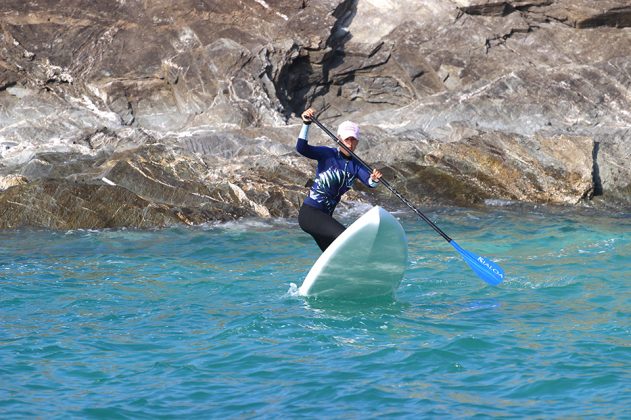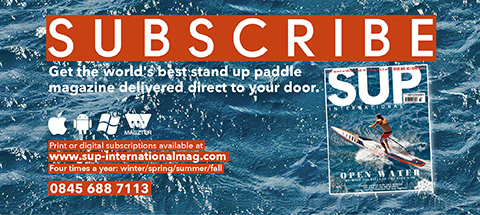PADDLE SCIENCE #4 –
THE ART OF BALANCE
Photos – Nick Lloyd
SUPers, surfers and skiers all have something in common. This is the need to make positional corrections incredibly quickly. The ability to do so depends upon a high level of balance which is critical for not only staying on your board but for getting better and for pushing your ability further. As SUP is performed on an unstable surface it requires even better reactive balance and proprioceptive control when compared to other sports.
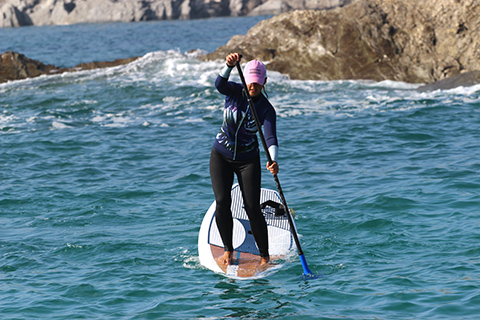
Nose paddle.
Balance, be it static or dynamic, relies upon three fundamental systems within the body:
1. Vestibular (inner ear) system. When you’re standing still, the fluid within your ear remains still. However, as soon as you turn your head, the fluid within your inner ear will move, sending signals to your brain in order to evaluate the speed of movement and change in position.
2. Somatosensory system. This system is critical for ‘feeling’. Within the skin, sensory receptors detect sensory input, enabling you to feel various things such as heat, cold, pressure, vibration etc. These sensations and sensory feedback are critical for keeping you stable and balanced.
3. Visual system. Without your eyes you would be unable to orient your head and trunk and would have difficulty knowing which way is ‘up’.
Good balance depends upon the successful integration of visual, vestibular and somatosensory information. These systems work together and allow the body to make fine adjustments to enable it to remain balanced within its base of support. When responding to a fast, changing environment, particularly in SUP surfing, positional changes must be made much faster than you are able to visually adjust. This relies on the somatosensory system where you gain feedback regarding the position of your body through receptors in your feet. This enables you to feel the rail of your board so that you know where your body is in relation to it. Every time you SUP therefore, you are able to train your somatosensory system which enables you to refine and ‘feel’ where your body is.
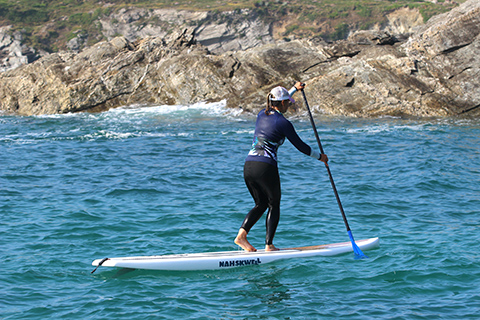
Cross step.
GO BARE FOOT FOR BALANCE
The somatosensory system plays a fundamental role in SUP balance. However, a large number of people are often tempted to wear shoes or wetsuit boots when SUPing, often due to a stony walk down a pebbly beach or due to the cold. Navigating uneven rocks, boulders and pebbles barefoot cannot only boost sensory and proprioceptive input at the feet and ankles but once on your board, research shows that SUPing barefoot is far better than wrapping your feet in neoprene. Going barefoot enables you to feel your board beneath you which greatly stimulates your somatosensory system. It promotes mechanoreceptor activity and helps relay high levels of proprioceptive input from the feet to the brain, helping to increase proprioception which in turn enhances your stability and control. Additionally, exercising barefoot not only improves your lower limb muscle strength, it helps to train both the intrinsic and extrinsic muscles within your feet. The intrinsic muscles are critical for maintaining a stable base of support on the water and help your feet to grip your board. SUPing barefoot is therefore excellent at increasing the activation of these small intrinsic muscles. Going barefoot also helps to boost both postural awareness and movement discrimination at the ankle. Indeed, in comparison to wearing shoes, the ability to make small positional changes and adjustments at the ankle has been found to be much better when barefoot. This is critical when SUPing on not only flat water but when increased balance is required in more unstable choppy conditions.
“ Research indicates that training on an unstable surface can positively improve strength and power which can enhance functional performance by a third ”
WHY TRAIN FOR BALANCE?
If you want to train your balance for SUP, training on an unstable surface is critical. SUPing on open water is the best and most functionally specific training platform as the water offers an unstable, unsteady surface on which to train which is not always easily replicated off the water. Compared to traditional training, research shows that training on an unstable surface places a far greater stress on the neuromuscular system, helping to improve balance control. It can also improve lower limb muscle strength and endurance. Strengthening the muscles at the hip, knee, ankle and foot is of particular importance with SUP to provide support and stability. A normal SUP session can be used to help stimulate increased strength and endurance of these key muscles. However, this strength can be challenged further in more specific balance training exercises.
Research indicates that training on an unstable surface can positively improve strength and power which can enhance functional performance by 31%. If you resistance train on an unstable surface – for example paddling against the wind and the current – functional performance can improve massively by 105%. This improvement will not only improve your SUP ability but will also translate to improvements in other sports such as running. Meanwhile, training on an unstable surface also improves joint stability by effecting the ligaments, joint capsule and muscles. The biggest contributor to proprioception at the ankle is the ligaments. This is why, if you’ve ever suffered any previous injury to your ankle ligaments, such as a ligament sprain, this can greatly reduce your proprioceptive function and can lead to chronic instability and re-injury. Training on the water can therefore help to generate rapid changes in the length of the ligaments which stimulates reflex motor responses for rapid joint stability. This is great for balance and also a useful tool for rehabbing any injuries you might have picked up.
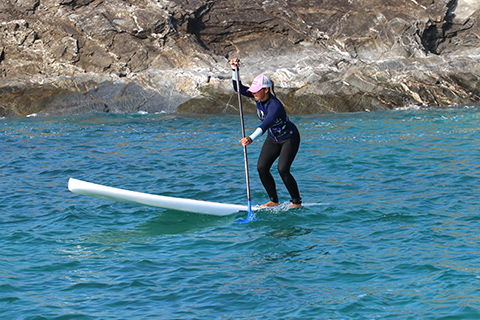
Tail paddle.
TRAINING FOR BALANCE
Getting out on the water and SUPing will naturally help to increase your balance. However, to challenge your balance further, don’t just limit yourself to paddling up and down as normal. Try the following fun and challenging exercises to start improving your SUP balance.
1. Stand in your normal SUP stance. Hold your paddle out in front of you with your arms straight. Using your body weight, rock your board side to side. The more vigorously you rock your board the more it will challenge your balance.
2. Walk to the back of your board and step back onto the tail as far as you feel comfortable. The nose of your board should rise out of the water in front of you. In this position paddle as normal, keeping your knees and hips slightly bent. To challenge yourself further, aim to stand further back on your board.
3. Repeat exercise 2. However, this time, walk to the nose of your board – this is often more difficult as the nose of your board tends to have no deck grip!
4. Walk up and down your board holding your paddle out in front of you.
If the above exercises still leave you wanting to be challenged further, consider performing them with your eyes closed. Or simply, stand on your board, get your balance and close your eyes. You’ll immediately find that this is much harder. The majority of people are visually dominant whereby you rely on your eyes to find your position in space. However, the visual system can be somewhat slow. Firstly, you need to see the information which then needs to be processed in the visual part of your brain before a signal is sent to your motor cortex to make an adjustment within the body. In comparison to this, somatosensory information is relayed extremely quickly resulting in extremely fast micro-adjustments of position. Closing your eyes takes your visual system out of the equation and forces you to rely more heavily on your somatosensory system. This is an excellent way of training this system, refining your ability to feel where your body is to improve your SUP balance.
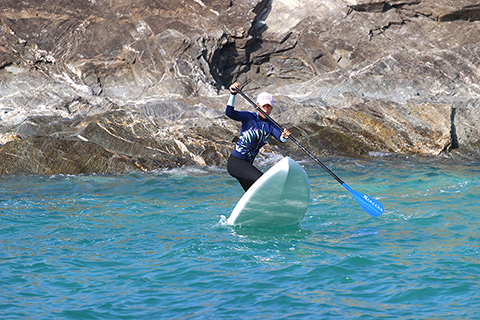
Kick turn.
SUP is a sport which is greatly reliant on a good sense of balance. If you’re a flat water paddler and looking to get out on choppier water, you’ll need better balance to keep you stable. If you’re keen to start SUP surfing small or bigger waves, again, better balance is needed to keep you on your board. The good news is that balance is trainable and SUP is perfectly suited for challenging your ability so that you can spend more time on the water, rather than in the water. SUP
Kate is a physiotherapist and standup paddler. Reach her at www.newquayphysio.co.uk

